
 i_need_contribute
i_need_contribute
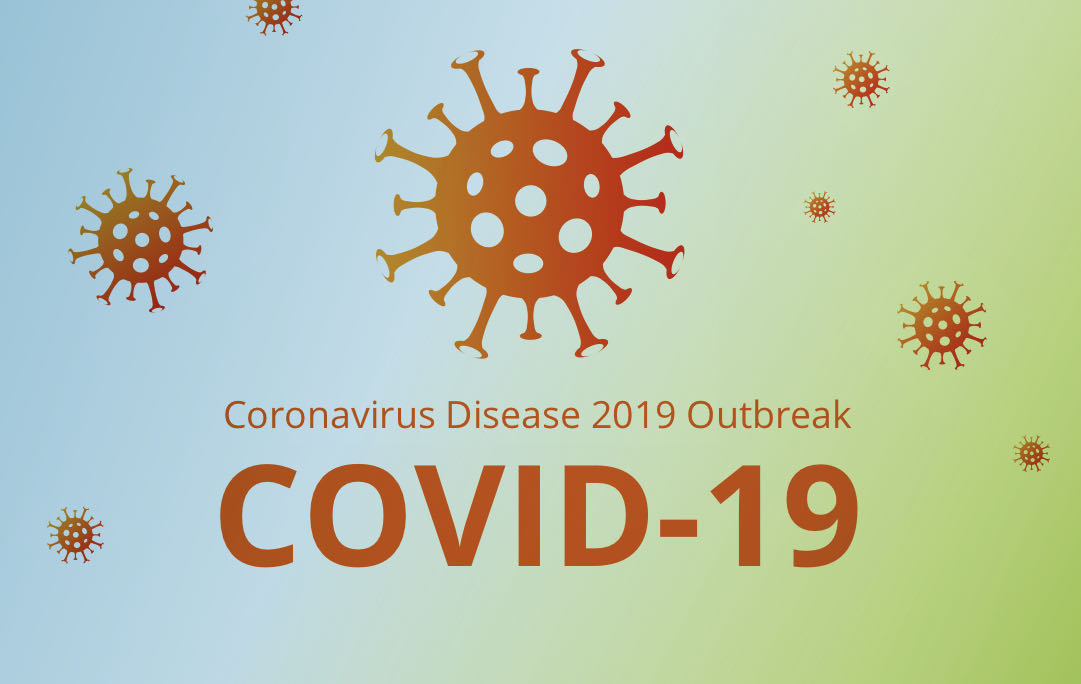
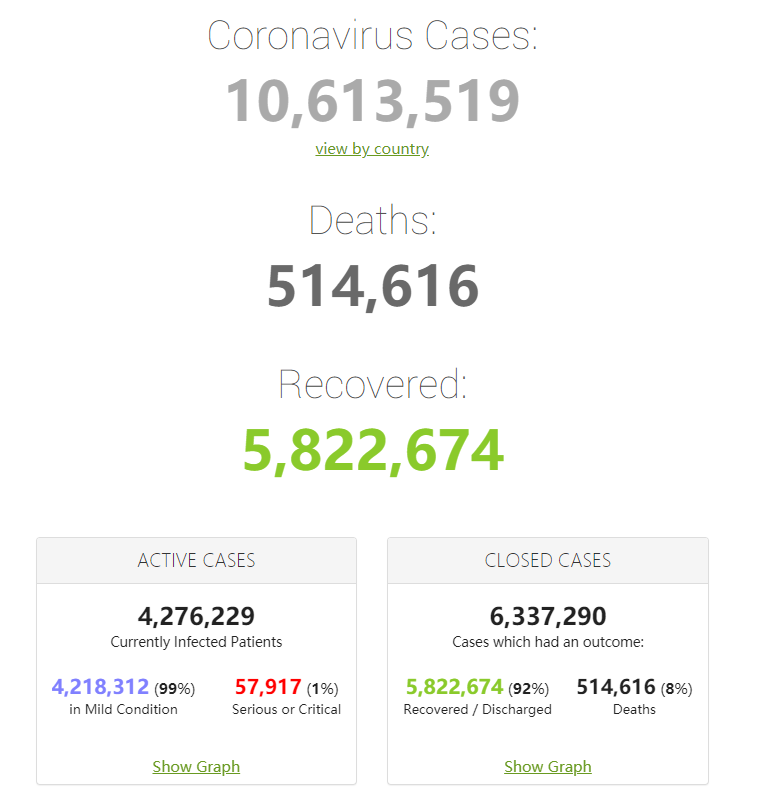
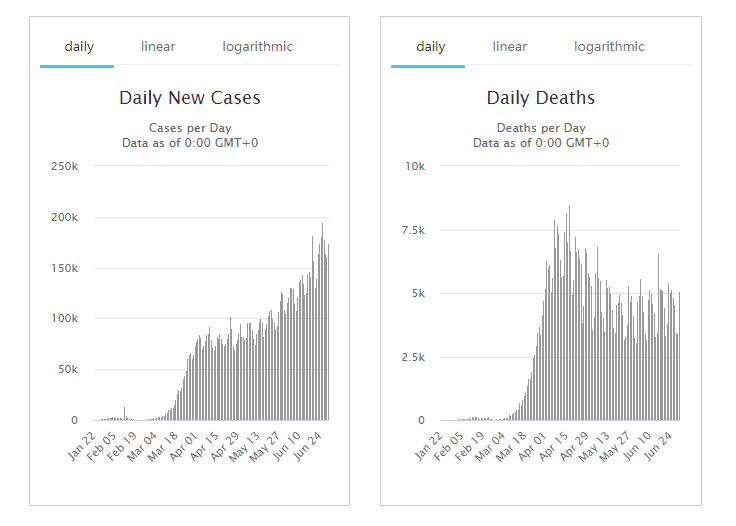
|
# |
Country, |
Total |
New |
Total |
|
|
World |
10,577,756 |
+174,264 |
513,186 |
|
1 |
2,727,853 |
+46,042 |
130,122 |
|
|
2 |
1,408,485 |
+37,997 |
59,656 |
|
|
3 |
647,849 |
+6,693 |
9,320 |
|
|
4 |
585,792 |
+18,256 |
17,410 |
|
|
5 |
312,654 |
+689 |
43,730 |
|
|
6 |
296,351 |
+301 |
28,355 |
|
|
7 |
285,213 |
+2,848 |
9,677 |
|
|
8 |
279,393 |
+3,394 |
5,688 |
|
|
9 |
240,578 |
+142 |
34,767 |
|
|
10 |
227,662 |
+2,457 |
10,817 |
|
|
11 |
220,657 |
+3,805 |
27,121 |
|
|
12 |
209,337 |
+2,825 |
4,304 |
|
|
13 |
199,906 |
+1,293 |
5,131 |
|
|
14 |
195,832 |
+440 |
9,052 |
|
|
15 |
190,823 |
+4,387 |
1,649 |
|
|
16 |
164,801 |
+541 |
29,843 |
|
|
17 |
151,209 |
+6,945 |
2,657 |
|
|
18 |
145,483 |
+3,682 |
1,847 |
|
|
19 |
104,204 |
+286 |
8,591 |
|
|
20 |
97,846 |
+2,803 |
3,334 |
|
|
21 |
96,088 |
+982 |
113 |
|
|
22 |
83,531 |
+19 |
4,634 |
|
|
23 |
68,451 |
+198 |
5,333 |
|
|
24 |
68,311 |
+1,557 |
2,953 |
|
|
25 |
64,530 |
+2,262 |
1,307 |
|
|
26 |
62,118 |
+328 |
392 |
|
|
27 |
61,427 |
+66 |
9,747 |
|
|
28 |
56,432 |
+767 |
4,527 |
|
|
29 |
56,385 |
+1,293 |
2,876 |
|
|
30 |
50,273 |
+50 |
6,113 |
|
|
31 |
49,109 |
+1,958 |
1,943 |
|
|
32 |
48,667 |
+421 |
315 |
|
|
33 |
46,195 |
+671 |
354 |
|
|
34 |
44,334 |
+706 |
1,159 |
|
|
35 |
43,907 |
+246 |
26 |
|
|
36 |
42,141 |
+229 |
1,576 |
|
|
37 |
40,070 |
+1,010 |
176 |
|
|
38 |
37,514 |
+1,076 |
1,266 |
|
|
39 |
34,393 |
+239 |
1,463 |
|
|
40 |
33,550 |
+765 |
631 |
|
|
41 |
32,568 |
+752 |
747 |
|
|
42 |
32,125 |
+601 |
1,071 |
|
|
43 |
31,714 |
+62 |
1,963 |
|
|
44 |
31,517 |
+279 |
746 |
|
|
45 |
26,970 |
+388 |
1,651 |
|
|
46 |
26,758 |
+519 |
87 |
|
|
47 |
25,694 |
+561 |
590 |
|
|
48 |
25,542 |
+415 |
443 |
|
|
49 |
25,473 |
+11 |
1,736 |
|
|
50 |
25,244 |
+803 |
320 |
|
|
51 |
21,819 |
+492 |
188 |
|
|
52 |
18,818 |
+736 |
485 |
|
|
53 |
18,593 |
+117 |
972 |
|
|
54 |
17,766 |
+43 |
705 |
|
|
55 |
17,741 |
+390 |
112 |
|
|
56 |
17,524 |
+556 |
213 |
|
|
57 |
17,409 |
+479 |
746 |
|
|
58 |
16,613 |
+256 |
545 |
|
|
59 |
14,564 |
+276 |
277 |
|
|
60 |
13,907 |
+336 |
912 |
Source:https://www.worldometers.info/coronavirus/
More than 48,000 coronavirus cases were announced across the United States on Tuesday, the most of any day of the pandemic. Officials in eight states — Alaska, Arizona, California, Georgia, Idaho, Oklahoma, South Carolina and Texas — also announced single-day highs.
The record comes as Dr. Anthony S. Fauci, the nation’s top infectious disease expert, testified before Congress on Tuesday that the rate of new coronavirus infections could more than double to 100,000 a day if current outbreaks were not contained. He warned that the virus’s march across the South and the West “puts the entire country at risk.”
Tuesday was the fourth time in a week that the United States posted a new single-day case record.
The number of new cases in the United States has shot up by 80 percent in the past two weeks, according to a New York Times database.
More than 4,600 new cases of the virus were announced in Arizona, by far its most in a single day, as Vice President Mike Pence planned to travel there on Wednesday. More than 7,800 new cases were announced across California and more than 6,800 in Texas.
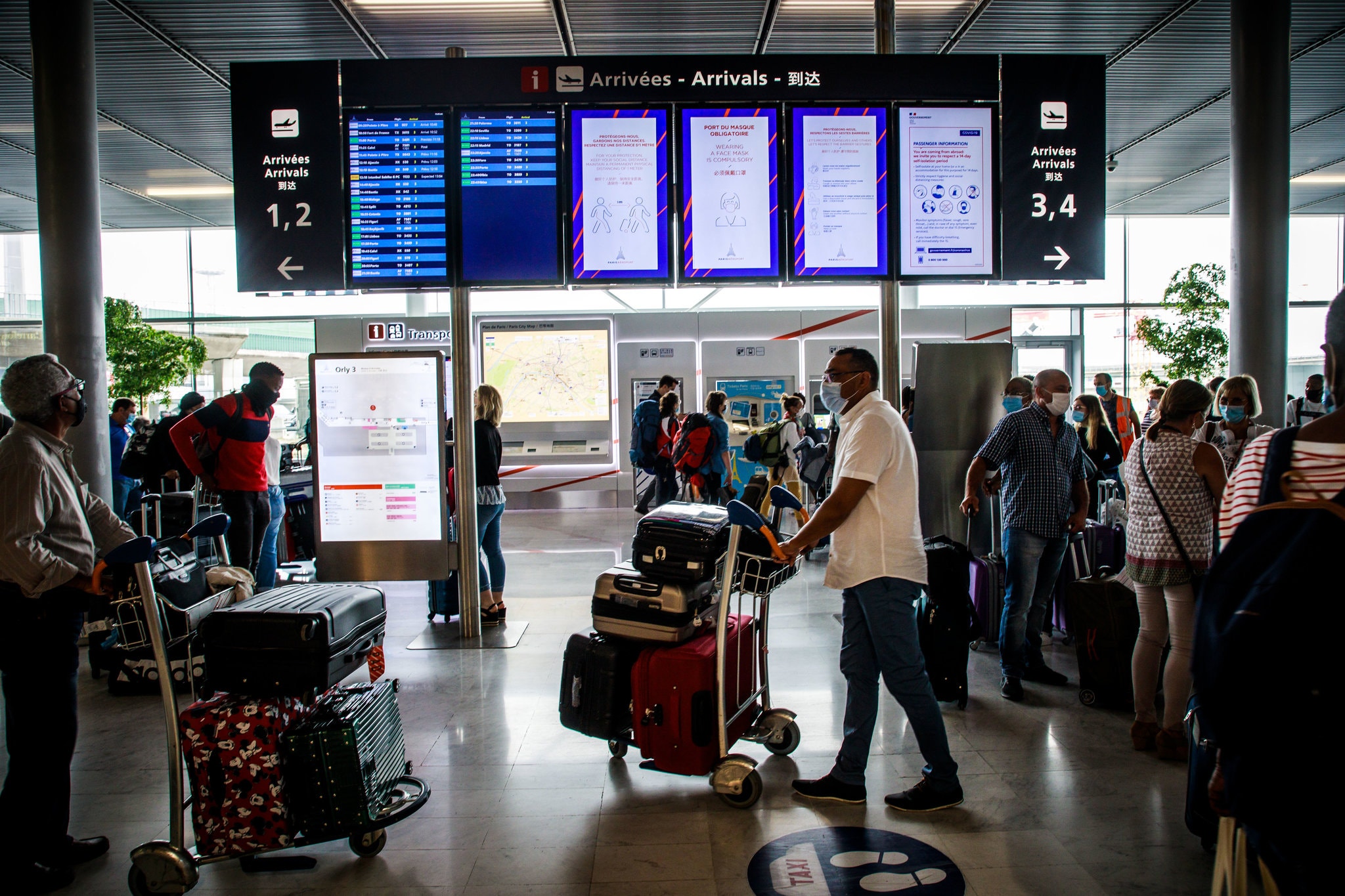
Orly Airport near Paris last week. The move by the European Union aims to balance health concerns with the need to bolster trade, not least the tourism industry.Credit...Christophe Petit Tesson/EPA, via Shutterstock
After months of lockdown, European nations are about to open their borders to nonessential travelers from a list of countries in which the pandemic has been deemed sufficiently under control. The United States is not on that list.
The State Department is still advising Americans to avoid all international travel, but many may be wondering what a newly reopening Europe might mean for them.
Here is what we know right now.
Who is allowed to enter?
As of July 1, all members of the European Union, as well as Iceland, Norway, Switzerland and Liechtenstein, plan to begin opening their borders to travelers from Algeria, Australia, Canada, Georgia, Japan, Montenegro, Morocco, New Zealand, Rwanda, Serbia, South Korea, Thailand, Tunisia and Uruguay. Residents of Andorra, San Marino, Monaco and the Vatican will also be allowed entry.
Are there any exceptions?
The restrictions do not apply to health workers, seasonal farm workers, diplomats, humanitarian workers, transit passengers, asylum seekers, students and “passengers traveling for imperative family reasons,” among a handful of other exceptions. The full list of exceptions here.
So is Europe out for Americans this summer?
Americans can fly to Ireland and Britain. All visitors, however, are required to quarantine for 14 days. Even then, they will probably not be able to travel on to the rest of Europe, unless they can prove they have a residence or immediate family links there.
What about U.S. citizens who live in a country on the approved list?
The rules are based on the country in which travelers are residents, not their nationalities. So American citizens may be allowed to enter Europe if they live in a country on the approved list. At the same time, citizens of approved countries who reside in the United States may not be allowed entry.

A coronavirus test site at Silver Creek High School in San Jose on Tuesday.Credit...Jim Wilson/The New York Times
As infections surge in the South and the West, the governors of New York, New Jersey and Connecticut — three former hot spots in the Northeast — called on Tuesday for travelers from California and several other states struggling to contain outbreaks to quarantine for 14 days upon reaching their states.
Gov. Andrew M. Cuomo of New York, a Democrat, said that visitors from an additional eight states — California, Georgia, Idaho, Iowa, Louisiana, Mississippi, Nevada and Tennessee — would be required to quarantine for 14 days upon arrival in the state. People traveling to New York from Alabama, Arkansas, Arizona, Florida, North Carolina, South Carolina, Texas and Utah had already been told to quarantine.
New Jersey and Connecticut are advising travelers from the 16 states to quarantine.
It was the latest example of how the shifting geography of the outbreak is once again upending travel regulations. The tristate area’s new restrictions now cover travelers from the nation’s most populous states, and from several of the busiest airports in the country, including those in Atlanta, Los Angeles and Dallas-Fort Worth.
In Massachusetts, which had previously required all visitors to quarantine for 14 days, Gov. Charlie Baker, a Republican, announced on Tuesday that beginning on Wednesday, the state would no longer require travelers from Rhode Island, Connecticut, Vermont, New Hampshire, Maine, New York and New Jersey to do so. “Due to lower infection rates across the Northeast region, our administration is updating our state’s travel guidance,” he said.
Other places are taking different approaches.
Starting July 15, people traveling to Puerto Rico will be required to bring proof of a negative test taken within three days of their arrival, the governor announced Tuesday. Anyone who doesn’t have one will be tested, and those who test positive will have to quarantine for two weeks, and must assume all medical and housing costs.
On Monday, the Department of Defense announced that it had lifted travel restrictions for service members to all but three states: California, Florida and Michigan.
Over the past week, California’s case count has increased significantly: It now has 231,842 confirmed cases, which have resulted in 6,081 deaths. On Tuesday, in an indication that the state’s hopes of easing more restrictions may be moving further out of reach, Gov. Gavin Newsom said that four more of the state’s 58 counties would likely be added to a “watch list” of places where officials are monitoring troubling trends in hospitalizations and positive tests. Some of the 19 counties on the list as of Tuesday afternoon have already been ordered to shut down bars, and many have paused plans to reopen until they can rein in rising case counts.

Times Square on March 7. Coronavirus antibodies began appearing in blood samples at one hospital in New York in February, scientists reported.Credit...Victor J. Blue for The New York Times
A new study offers the first physical evidence that the coronavirus was circulating at low levels in New York City as early as the first week of February.
The city confirmed its first infection on March 1. Mathematical models have predicted that the virus was making its way through the city weeks before then, but the new report is the first to back the conjecture with testing data.
The study found that some New Yorkers had antibodies to the virus as early as the week ending Feb. 23. Given the time needed to produce antibodies, those people were most likely infected with the virus about two weeks earlier.
“You’re probably talking about very early in February,” said Florian Krammer, an immunologist at the Icahn School of Medicine at Mount Sinai, who led the study. “It looks like there was at least low-level circulation.”
The findings were posted online Tuesday and have not yet been vetted by other scientists in a formal review, but several experts said the work was rigorous and credible, if not entirely surprising.
Dr. Krammer is continuing to track antibodies in blood samples and plans to do so for at least a year.

San Quentin State Prison in California this week.Credit...Justin Sullivan/Getty Images
An effort by California officials to halt the spread of the virus at a prison in Chino backfired and caused a massive outbreak inside San Quentin, the state’s oldest and best-known prison.
Late last month, 121 prisoners from the California Institution for Men in Chino, which had nearly 700 cases and nine deaths, were bused to San Quentin, where no inmates were known to have the virus.
When they arrived, prisoners’ temperatures were taken and they were placed in a holding area, but no Covid-19 tests were given. The men used the same showers and ate in the same dining hall as other inmates.
Now more than 1,000 of the 3,700 prisoners at San Quentin have been infected.
A hearing is scheduled on Wednesday in the State Senate, where lawmakers say they have become alarmed about the outbreak and what they describe as a haphazard response by prison officials.
Since the pandemic began, California has agreed to release as many as 3,500 inmates up to six months early and is considering more early releases, but the prison system remains at 124 percent capacity, according to state records.
Across the United States, the number of prison and jail inmates known to be infected has doubled during the past month to more than 80,000, according to a New York Times database. Nine of the 10 largest known clusters of the virus in the United States are inside correctional institutions, The Times’s data shows.

Checkpoints were set up along the roads to Vo’ in February.Credit...Andrea Casalis/Andrea Casalis, via Associated Press
Three days after a 78-year-old man, Adriano Trevisan, died on Feb. 21 and became the first registered victim of the coronavirus in Italy, the government imposed a 14-day quarantine on Vo’, the small town near Padua where he lived.
Backed by the Veneto region, scientists swab-tested nearly all of the town’s 3,275 residents, both at the beginning and at the end of the lockdown.
On Tuesday, the results of the study were published in the journal Nature. It found that 42.5 percent of the cases showed no symptoms, indicating that asymptomatic cases might have been important — if unwitting — spreaders of the pandemic, and confirming the importance of widespread testing.
The study also found that local outbreaks could be controlled “by combining the early isolation of infected people with community lockdown.”
Andrea Crisanti, the top scientific consultant on the virus in Veneto and a professor at the University of Padua and Imperial College London, co-led the study and has been a forceful advocate of widespread testing. He argued in the paper that the Veneto region’s testing and tracing approach had a “tremendous impact on the course of the epidemic in Veneto compared to other Italian regions.”
“The experience of Vo’ shows that despite the silent and widespread transmission of SARS-CoV-2, transmission can be controlled,” the authors wrote.
The study showed that at the start of the quarantine, 73 residents of Vo’, or 2.6 percent of the population, tested positive for the virus. Two weeks later, that number had dropped to 29 people, eight of which were new cases, but in both rounds of testing, 40 percent of the positive cases had been asymptomatic.
Transmission in the absence of symptoms poses clear challenges for the control of Covid-19 without strict social distancing measures or epidemiological surveillance comprising, for instance, a test, trace and isolate strategy, the study noted.

Airbus A350 aircraft at the company’s factory near Toulouse, France, in June.Credit...Stephane Mahe/Reuters
The pandemic continued to wreak havoc on global aviation as the aerospace giant Airbus announced Tuesday that it would cut nearly 15,000 jobs across its global work force, the largest downsizing in the company’s history.
Citing a 40 percent slump in commercial aircraft business activity and an “unprecedented crisis” facing the airline industry, Airbus said it would cut around 10 percent of its jobs worldwide, with layoffs hitting operations in France, Germany, Spain and Britain.
The chief executive, Guillaume Faury, had been preparing employees for hard times in a series of recent memos in which he warned it would be necessary to adapt to a “lasting decline” in the demand for airliners. The company said Tuesday that it did not expect air travel to return to pre-virus levels before 2023 and potentially not until 2025.
“Airbus is facing the gravest crisis this industry has ever experienced,” Mr. Faury said on Tuesday. “We must ensure that we can sustain our enterprise and emerge from the crisis as a healthy, global aerospace leader, adjusting to the overwhelming challenges of our customers.”
The layoffs are a stunning reversal of fortune for the world’s largest plane maker, which was founded 50 years ago.
From CNN's Shelby Lin Erdman
It’s still unclear to what extent children may spread the coronavirus, but a new study suggests it is possible they can transmit it as easily as infected adults, Swiss researchers reported Tuesday.
Fewer children than adults contract Covid-19, fewer develop severe forms of the illness and they don’t seem to be “major drivers of transmission,” but children of all ages have been infected, researchers said.
“Despite the high proportion of mild or asymptomatic infections, they should be considered as transmitters unless proven otherwise,” researchers from the Geneva University Hospitals and the University of Geneva concluded.
In the survey, 23 children ranging in age from 7 days old to 16 tested positive for Covid-19 and all but two carried the same amount of virus as adults.
“Our data show that viral load at diagnosis is comparable to that of adults and that symptomatic children of all ages shed infectious virus in early acute illness, a prerequisite for further transmission,” the authors wrote.
However, children do not seem to spread the virus in the same way adults do.
“Considering the relatively low frequency of infected children, even in severely affected areas, biological or other unknown factors could lead to the lower transmission in this population,” the authors surmised.
They said more research is need to fully understand the role of children in spreading the virus.
The study had some limitations, including its small size and the use of virus samples left over from routine diagnostic tests.
The research was published in the journal Emerging Infectious Diseases.
From CNN's Lilit Marcus and Yoko Wakatsuki

People arrive at Tokyo Disneyland on the reopening day on July 1, in Tokyo, Japan. Philip Fong/AFP/Getty Images
All of Disney's Asia parks have now officially reopened, with Tokyo Disney Resort welcoming visitors to its two theme parks from July 1.
Both Tokyo Disneyland and Tokyo DisneySea have been closed since late February due to the coronavirus pandemic.
Shanghai Disneyland was the world's first Disney park to reopen, welcoming guests from May 11 with protocols about social distancing and mandatory mask wearing, and Hong Kong Disneyland followed suit a month later.
Oriental Land, the company that operates the Tokyo Disneyland and DisneySea parks in Japan, has announced its own guidelines for ensuring guest and staff safety going forward. These include advance ticket booking, mandatory temperature checks and social distancing while enjoying the attractions.
From journalist Rodrigo Pedroso in Sao Paulo.
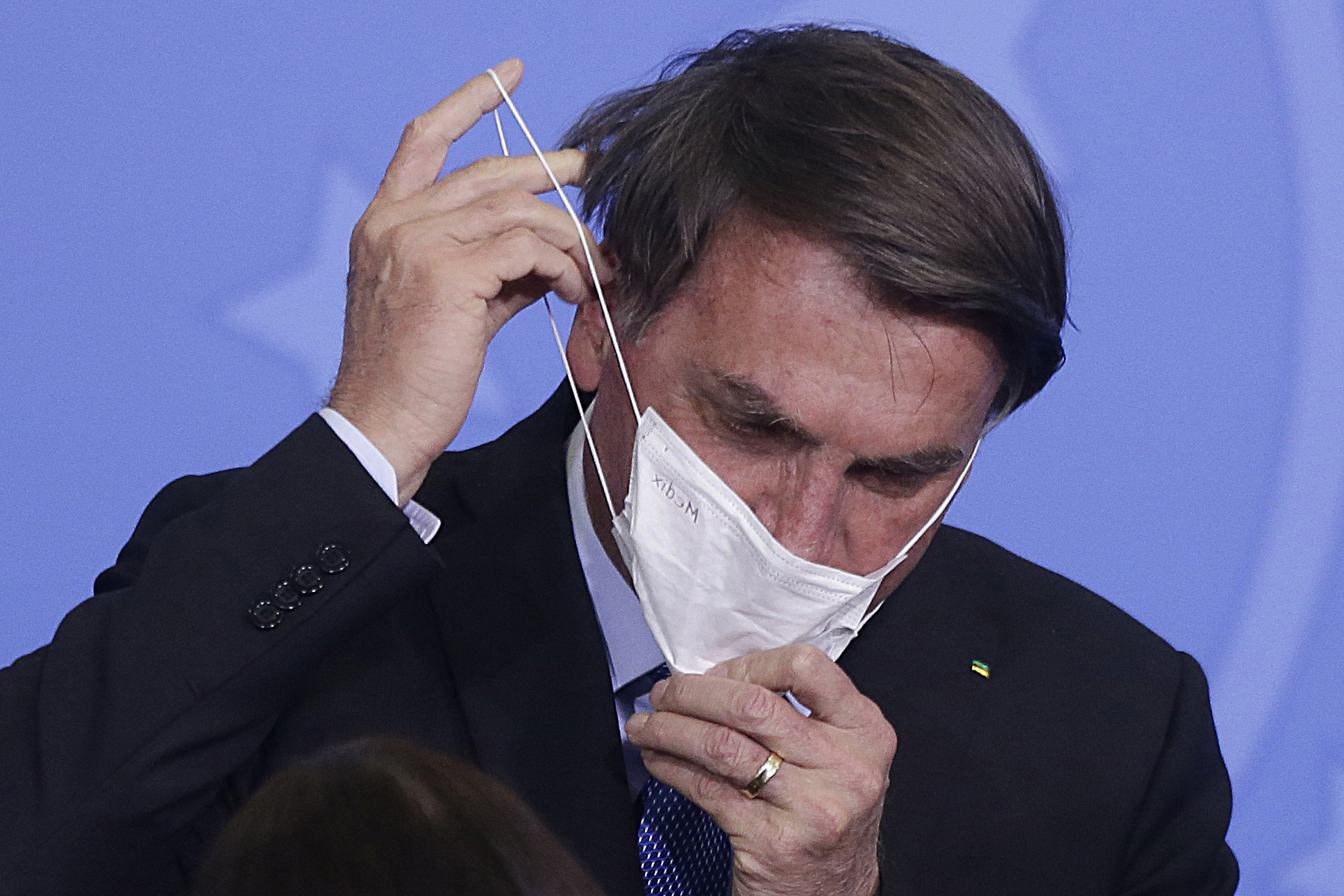
Brazilian President Jair Bolsonaro during the ceremony to extend emergency aid to informal workers, at the Planalto Palace, in Brasilia, Brazil, on June 30, 2020. Dida Sampaio/Agencia Estado/AP Images
A Brazilian federal judge overturned an order Tuesday that mandated President Jair Bolsonaro to wear a mask in public or face a fine.
Bolsonaro appealed to the federal court to avoid being obliged to wear face masks in public on Friday.
The court order given on June 26 by judge Renato Borelli -- of the 9th Federal Civil Court of the Federal District -- attested a decree issued on April 30 by the Federal District government.
The decree established that the use of face masks became mandatory as a measure to curb the spread of the coronavirus pandemic. Bolsonaro would have faced fines of 2,000 reals a day ($366) if he breached the order.
Judge Daniele Maranhão Costa, of the Federal Regional Court, said a legal judgement, or injunction, was not appropriate in this case against Bolsonaro. The judge said the judiciary is not the appropriate place to resolve that sort of matter.
"I recognize the absence of a need to file a lawsuit of origin for the purpose of compelling citizens to wear masks, regardless of the position they occupy in the state administration," Costa said.
Bolsonaro took to the streets near the Federal District without protective equipment several times before the mask order was overturned.
From CNN's Samantha Beech
The United Nations Security Council is expected to adopt a resolution by virtual vote Wednesday, calling on countries to adopt a halt in hostilities to focus on the Covid-19 virus, according to a draft of the resolution seen by CNN.
Almost four months after the World Health Organization declared the coronavirus a global pandemic on March 11, this is the first action by the UN wing tasked with protecting international peace and security. The council was widely denounced for failing to agree on any action as more than 10 million people contracted the virus and various wars continued over several months.
A hot dispute between China and the US blocked agreement for months. The US wanted no mention of WHO and China was furious when the US insisted on blaming Beijing for the virus in the early months of the negotiations.
There is no mention of WHO in the final draft resolution. The resolution does call for "a general and immediate cessation of hostilities in all situations on its agenda and supports the efforts undertaken by the Secretary-General.”
It says a ceasefire of at least 90 days would help “enable the safe, unhindered and sustained delivery of humanitarian assistance” during the coronavirus outbreak. The fight against ISIS and terrorism in Iraq is exempt.
Despite more than 100 countries agreeing with the goal, the UN has acknowledged the impact of the call by UN Secretary-General António Guterres for a ceasefire due to the virus has not had a dramatic impact.
The vote is taking place over a two-day period and will be conducted virtually due to the closure of the council chamber months ago when the outbreak hit.
Source:https://edition.cnn.com/world/live-news/coronavirus-pandemic-07-01-20-intl/index.html
· Cases worldwide are nearing 10.5m. There are 10,450,628 confirmed coronavirus cases worldwide, and 510,632 deaths, according to the Johns Hopkins University tracker.
· The US saw a record one-day case increase. Tuesday saw 44,358 new coronavirus cases confirmed in the US, according to The Covid Tracking Project, which said on Twitter that the 7-day average for new daily cases as doubled since 13 June and that hospitalisations in the country jumped by the highest number since 21 April. Tuesday saw 44,358 new coronavirus cases confirmed in the US, according to The Covid Tracking Project, which said on Twitter that the 7-day average for new daily cases as doubled since 13 June and that hospitalisations in the country jumped by the highest number since 21 April.
· Deaths in Brazil, the second-worst affected country after the US, are nearing 60,000. Brazil has suffered 1,280 more deaths, bringing the country’s confirmed death toll to 59,594, according to Health Ministry data.The total number of confirmed cases rose by 33,846 to reach 1,402,041, the worst outbreak in the world outside the United States.
· Australia locked down 300,000 in Victoria state suburbs. Authorities will lock down around 300,000 people in suburbs north of Melbourne for a month from late on Wednesday to contain the risk of infection after two weeks of double-digit rises in new coronavirus cases in Australia’s second most populous state.
· The UN warned jobs figures are worse than feared. The pandemic has taken a much heavier toll on jobs than previously feared, the UN says, warning the situation in the Americas is particularly dire.In a fresh study, the International Labour Organization (ILO) estimates that by the mid-year point, global working hours were down 14 percent compared to last December - equivalent to some 400 million full-time jobs.
· Three asylum seekers at camp near US border tested positive for coronavirus. Three asylum seekers have tested positive for coronavirus in a sprawling border encampment, marking the first cases in a settlement that advocates have long viewed as vulnerable amid the pandemic, Reuters reports.
· The US has bought up virtually all the stocks for the next three months of remdesivir, one of the two drugs proven to work against Covid-19, leaving none for the UK, Europe or most of the rest of the world, my colleague Sarah Boseley reports. Experts and campaigners are alarmed both by the US unilateral action on remdesivir and the wider implications, for instance in the event of a vaccine becoming available. The Trump administration has already shown that it is prepared to outbid and outmanoeuvre all other countries to secure the medical supplies it needs for the US.
· South Korea is treating severe coronavirus cases with remdesivir. South Korea’s Yonhap News Agency reports that South Korea has started providing remdesivir to patients for coronavirus treatment.
· Dr Anthony Fauci told US senators he “would not be surprised” if cases go up to 100,000 a day. He said the US is “going in the wrong direction” in its handling of the coronavirus pandemic and warned that the death toll “is going to be very disturbing” unless officials intervene, and urged Americans to wear masks and practice social distancing in public spaces.
· Speaking in Delaware, Joe Biden said the pandemic is unlikely to have subsided by January 2021, and if he’s elected. “On the day I’m sworn in, I’ll get right to work implementing all aspects of the response that remain undone,” he said.
· The United Nations has called on governments to provide nearly $10bn in aid for Syria, as the war-torn country’s humanitarian crisis deepens amid the coronavirus pandemic. The UN said it needed $3.8bn to help 11 million people in Syria – where food prices have soared – and a further $6.04bn to help the 6.6 million Syrians who have fled the country.
· Greece should prepare for a “very difficult” tourist season, the country’s prime minister has said. Tourism officials say the country – which usually makes around 18.1 billion a year from tourism – would be lucky if revenues hit the 4-5 billion euro mark this year.